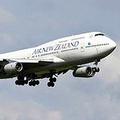 紐西蘭航空12月30日率先完成世上商用航空器首度混合使用生質燃料的飛行測試,測試的客機四只引擎之一採用由麻瘋樹(jatropha)提煉而出的生質燃料,考驗此燃料可否符合飛行所用。
紐西蘭航空12月30日率先完成世上商用航空器首度混合使用生質燃料的飛行測試,測試的客機四只引擎之一採用由麻瘋樹(jatropha)提煉而出的生質燃料,考驗此燃料可否符合飛行所用。
紐航在這次2小時的飛行測試中,首度使用麻瘋樹屬植物籽油作為合成的生質燃料,且為麻瘋樹籽所煉製的第二代生質燃料,具有減少溫室氣體排放與降低成本等效益。
測試的飛機12月30日上午由奧克蘭國際機場起飛,裝載麻瘋樹與Jet A1以50:50比例合成的生質燃料,負責推進其中一只紐西蘭波音747-400 Rolls-Royce RB211引擎。
當測試機以全動力起飛並攀升至35,000英呎高空後,負責研究的機組人員開始進行一系列的測試報告,確切掌握引擎與燃油系統在不同高度及狀況下的實際運作情形。
 麻瘋樹屬植物的種籽富含不可食用的脂質,卻是提煉生質燃料的好原料。除了每顆種籽可以產生佔自身質量30-40%的油脂外,麻瘋樹可適應嚴苛的環境,包括貧瘠或非耕作之地;換句話說,栽植麻瘋樹並不會剝奪其他糧食作物的生長空間。
麻瘋樹屬植物的種籽富含不可食用的脂質,卻是提煉生質燃料的好原料。除了每顆種籽可以產生佔自身質量30-40%的油脂外,麻瘋樹可適應嚴苛的環境,包括貧瘠或非耕作之地;換句話說,栽植麻瘋樹並不會剝奪其他糧食作物的生長空間。
當初紐航與合作夥伴對於生質燃料的選用設有相當高的門檻,若無法符合三項永續環境的標準,則絲毫不考慮採用並進行下一階段的試飛計劃。
首先,燃油必須是永續環境的來源,並且與當今糧食作物的耕地相容。
其次,該燃料必須擁有快速取代傳統航空煤油的特性,並且在技術上可生產同等於今日燃油的水準。
最後,該燃料必須比現用燃料來源更具成本效益,且可穩定供應。
 紐航指出,30日飛行測試當天所採用的麻瘋樹種來自馬拉威、莫三比克和坦桑尼亞。麻瘋樹籽油的來源,不需至雨林也不用到20年內未經開發的草原處女地。麻瘋樹生長於土壤貧瘠和氣候嚴峻的環境,反而不適合一般糧食作物生長。此外,此次飛行測試生質燃油來源的麻瘋樹田,是採天然降雨而非經由機械系統來灌溉。
紐航指出,30日飛行測試當天所採用的麻瘋樹種來自馬拉威、莫三比克和坦桑尼亞。麻瘋樹籽油的來源,不需至雨林也不用到20年內未經開發的草原處女地。麻瘋樹生長於土壤貧瘠和氣候嚴峻的環境,反而不適合一般糧食作物生長。此外,此次飛行測試生質燃油來源的麻瘋樹田,是採天然降雨而非經由機械系統來灌溉。
紐航計劃於2013年以前將永續生質燃料的實際需求提升之10%。2009年1月,國際間兩家航空公司也將加入測試生質合成燃油的測試行列。美國大陸航空預訂於1月7日,將進行複合海藻與麻瘋樹的生質燃油飛行測試。此次測試將是首次使用海藻作為生質燃料來源的商業載具飛行測試、首次使用雙引擎的飛行器,也是美國航空業者首次展現生質燃料的飛行成果。在太平洋的另一端,日本航空正緊鑼密鼓地計劃以亞麻薺籽油(camelina oilseed)作為生質燃料基底,於1月30日由東京起飛測試,視此為削減溫氣氣體排放的新作為。
A passenger jet with one of its four engines running on a biofuel blend today completed the world's first commercial aviation test flight to test a biofuel made from jatropha, Air New Zealand said.
The two hour Air New Zealand test flight was powered by a second-generation biofuel made from the seeds of the jatropha plant that could reduce emissions and cut costs. The flight was the first to use jatropha jatropha seed oil as part of a biofuel mix.
The test flight took off from Auckland airport this morning with a biofuel blend of 50:50 jatropha and Jet A1 fuel powering one of the Air New Zealand Boeing 747-400's Rolls-Royce RB211 engines.
After a full-power takeoff and ascent to 35,000 feet, they undertook a number of fuel tests confirming and measuring the performance of the engine and fuel systems at various altitudes and under a variety of operating conditions.
Jatropha is a plant that produces seeds that contain inedible lipid oil that is used to produce the fuel. Each seed produces 30-40 percent of its mass in oil and jatropha can be grown in a range of difficult conditions, including arid and otherwise non-arable areas, leaving prime areas available for food crops.
Air New Zealand and its partners have been non-negotiable about the three criteria any environmentally sustainable fuel must meet for the test flight program.
First, the fuel source must be environmentally sustainable and not compete with existing food resources.
Second, the fuel must be a drop-in replacement for traditional jet fuel and technically be at least as good as the product used today.
Finally, it should be cost competitive with existing fuel supplies and be readily available.
The jatropha used on Tuesday's flight was grown in Malawi, Mozambique and Tanzania, the airline said. The criteria for sourcing the jatropha oil required that the land was neither forest land nor virgin grassland within the previous two decades. Jatropha grows on poor soil and in arid climates not suitable for most food crops. The jatropha farms that grew the seeds for this test flight are rain-fed and not mechanically irrigated.
Air New Zealand aims to meet 10 percent of its fuel needs through sustainable biofuel by 2013.
In January, two more airlines will test their biofuel blends. Continental Airlines on January 7 will conduct a test flight powered by a blend involving algae and jatropha. The flight will be the first biofuel flight by a commercial carrier using algae as a fuel source, the first using a two-engine aircraft, and the first biofuel demonstration flight of a U.S. commercial airliner.
On January 30, Japan Airlines is planning a test flight from Tokyo using a fuel based on the camelina oilseed as a way to cut greenhouse gas emissions.




